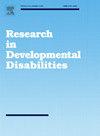生理参数与自我伤害相关研究的系统综述
IF 2.9
2区 医学
Q1 EDUCATION, SPECIAL
引用次数: 0
摘要
背景自残在智障人群中很常见,并与自我伤害的案主、其他案主和照顾者的多重不良后果有关。根据观察和自我报告的数据,自残与情绪失调有关。自主神经系统的测量可能为这种关系提供额外的见解。方法本系统综述系统总结了有关自残与生理参数之间关系的广泛研究。检索确定了2400篇文章,其中包括46篇。结果在大多数比较有和无自残行为的人的皮电活动和心率的研究中,没有发现生理和自残行为之间的明确关系。对心率变异性的研究表明,在恢复过程中心率变异性较低,这可能意味着情绪失调,这一发现得到了图像研究(心率和皮肤电导)结果的支持。在实际发生自残之前、期间或之后对自残进行研究时,没有发现一致的结果,尽管这方面的研究很少。结论虽然可穿戴技术已经得到了改进,但迄今为止大多数研究都是实验室研究。未来的研究应侧重于对智力残疾者自残前、中、后日常生活中的生理测量,分别研究不同类型和功能的自残,检验多模态预测模型。这些知识可以提高对这种使人衰弱的行为的理解、预防和评估。本文章由计算机程序翻译,如有差异,请以英文原文为准。
A systematic review of studies on the association between physiological parameters and self-harm
Background
Self-harm is common in people with intellectual disabilities and is associated with multiple adverse consequences for the client engaging in self-harm, other clients and caregivers. Self-harm is related to emotional dysregulation according to both observational and self-report data. Measures of the autonomic nervous system might provide additional insight in this relationship.
Methods
The current systematic review systematically summarized a broad spectrum of studies on the association between self-harm and physiological parameters. The search identified 2400 articles, 46 were included.
Results
In most studies, which compared electrodermal activity and heart rate in people with and without self-harm, no clear indications for a relation between physiology and self-harm was found. Studies on heart rate variability showed indications for lower heart rate variability during recovery, which could imply emotion dysregulation, findings which were supported by results from imagery studies (heart rate and skin conductance). No consistent findings were found when self-harm was studied before, during or after actual occurrences of self-harm, although this was examined by very few studies.
Conclusions
Although wearable technology has improved, the majority of studies to date are lab-studies. Future research should focus on measuring physiology in daily life before, during and after self-harm, in people with intellectual disabilities, study different types and functions of self-harm separately, and test multimodal prediction models. This knowledge could improve the understanding, prevention and assessment of this debilitating behaviour.
求助全文
通过发布文献求助,成功后即可免费获取论文全文。
去求助
来源期刊

Research in Developmental Disabilities
Multiple-
CiteScore
5.50
自引率
6.50%
发文量
178
期刊介绍:
Research In Developmental Disabilities is aimed at publishing original research of an interdisciplinary nature that has a direct bearing on the remediation of problems associated with developmental disabilities. Manuscripts will be solicited throughout the world. Articles will be primarily empirical studies, although an occasional position paper or review will be accepted. The aim of the journal will be to publish articles on all aspects of research with the developmentally disabled, with any methodologically sound approach being acceptable.
 求助内容:
求助内容: 应助结果提醒方式:
应助结果提醒方式:


